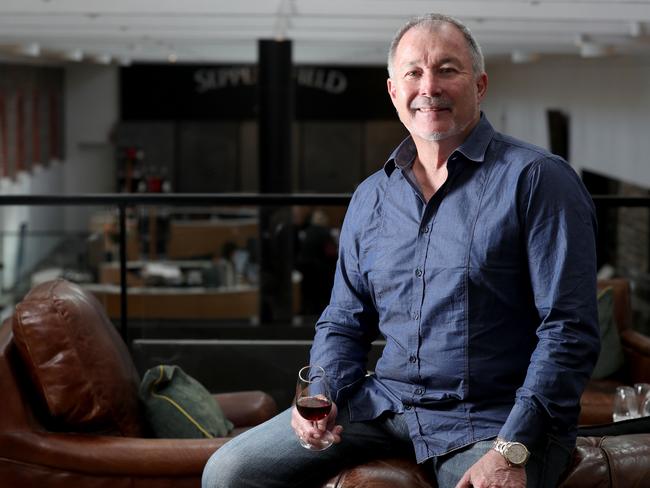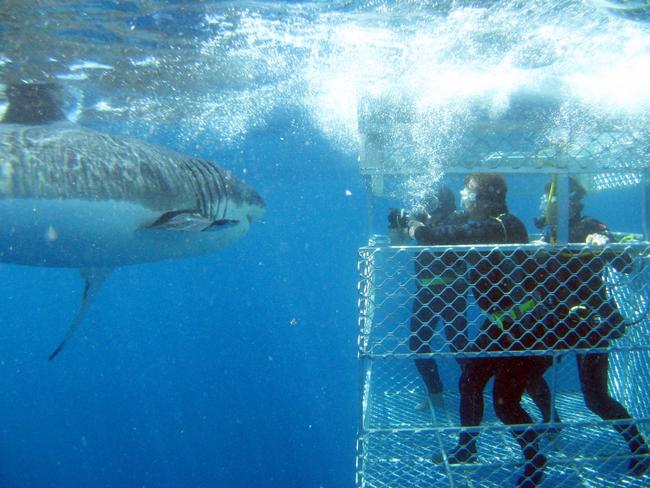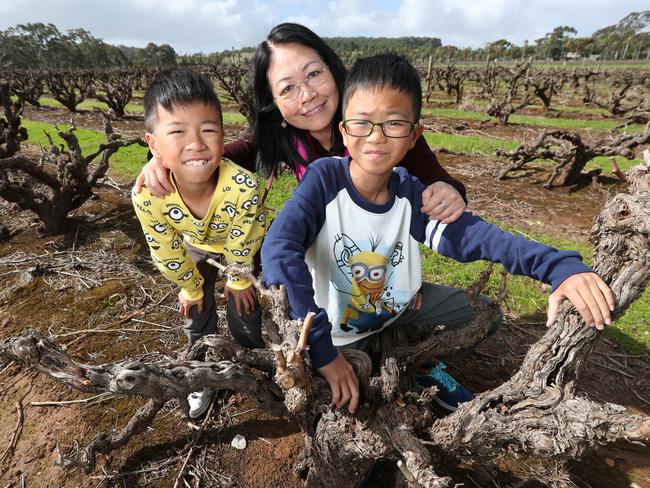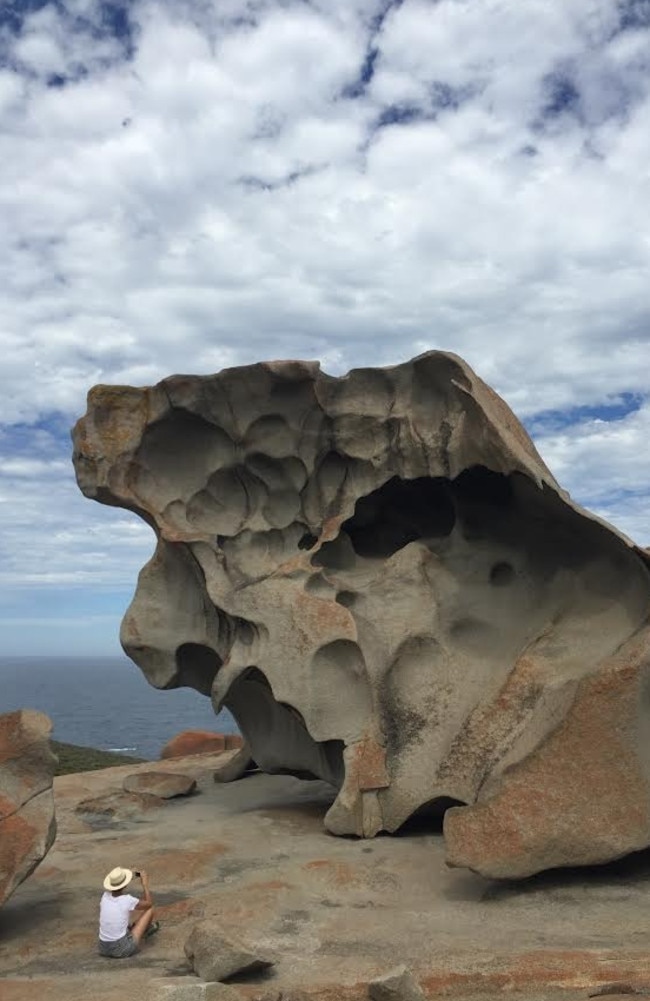South Australia’s tourism industry is enjoying high times — but is it enough?
SOUTH Australia boasts great wine, beautiful beaches and outback adventures. But as the entire nations enjoys growth in visitor numbers and spending is the state getting its fair share?
SA News
Don't miss out on the headlines from SA News. Followed categories will be added to My News.
HONG KONG couple Teddy Law and Joyce Cheng are walking through one of Australia’s most important wine collections — an unbroken lineage of tawny port of every vintage from 1878.
They have just finished lunch at a restaurant that has this year been named one of the best in the country specialising in fresh local produce.
The pair sample wine at a cellar door that has been awarded the title of the best in the world.
Outside, their children Angus, 12, and Anson, 9, dart in and out of the skeletal frames of grape vines on the Seppeltsfield estate — a combination of more than 170ha of ancient vineyard, gardens and heritage-listed architecture.
Mr Law, who works in IT, and Ms Cheng, a social worker, typify the new breed of visitors to our state — middle-class Asian people looking for world- class experiences.

They want good food, good wine and good views.
“I wanted to find a winery with a long history to do some wine tasting,” Mr Law said. “Seppeltsfield is so historical.”
Ms Cheng adds: “We had a very delicious meal.”
Before arriving in SA, they visited Tasmania and Melbourne. They were drawn from Melbourne to Adelaide via the Great Ocean Rd, and to the Barossa Valley on the promise of great wine and historic architecture.
The growth in Asian tourism to South Australia has changed the industry dramatically.
But the story of SA is not unique. Asian visitor numbers, particularly from China, have skyrocketed across the country in the past decade.
Seppeltsfield Estate, which holds the mantle of Australia’s Best Tourism Winery courtesy of Australia’s most important tourism awards, is providing a perfect example of how SA can capture the tourism market.
South Australia has beautiful beaches, world-renowned wines, laneways buzzing as visitors eat and drink the nights away, sensational sunsets, breathtaking Outback, a safe capital city and coastal bush walks that rival almost anything on the planet.

The state should be a tourism marketer’s dream.
Adelaide was again named the fifth most liveable city in the world during the week by The Economist, while travel bible Lonely Planet nominated the state as one of its top five regions to visit in 2017.
And for two years in a row SA has been crowned the Best Event State at the most prestigious tourism awards in the country.
But despite these accolades, is SA really keeping pace with our interstate rivals when it comes to visitor numbers? Are we really grabbing our share of the national tourism pie?
It is an issue that is spoken about quietly in tourism circles, by operators who are reluctant to talk publicly about the challenges facing the industry. Industry insiders say speaking out will all but guarantee your tourism venture is the last to feature on any government promotional material spruiking the state, or involvement in carefully managed media opportunities.
SA Tourism Minister Leon Bignell is quick to point out positive figures for the local industry, including a record high visitor economy of $6.3 billion (up 30 per cent in four years since 2013), planned hotel developments worth $1.2 billion and increases in the number of both international flights and cruise ships arriving.

However Mr Bignell did not address a raft of statistics put to his office that show SA is lagging behind the nation in a number of measures.
Tourism statistics published by the State Government show between the year ending March 2008 and March this year, the number of visitors grew by 19 per cent. Overall visitors to Australia in the same period grew by 50 per cent. Domestic visitors, that make up the majority share of tourists in Australia, grew by 11.6 per cent in SA over the same period compared to 21.3 per cent nationally. And the number of nights domestic visitors spent in SA grew by 11.6 per cent, below the 14.4 per cent national rate.
Mr Bignell tells the Sunday Mail prosperity is ultimately about dollars in the pockets of business.
“So the measure of success for us is always skewed towards what dollars visitors spend and what they spend it on, not how many people come here,” he says.
“Our fundamental offering is based around unique and high quality food, wine and nature, and the accessible, affordable and immersive experience visitors have around that offering.”
But the latest expenditure figures, produced by the South Australian Tourism Commission, show international visitors spend on average $2450 when in SA — more than $1000 less than the average across all states of $3525.

Cruise ship numbers to SA have also risen in recent years but are a drop in the ocean when compared to much of the country.
National figures for the Australian cruise industry show in the 2015-16 financial year SA welcomed 37 cruise ships. Cairns alone had 50 visits, Fremantle 58, Tasmania 56 and the Northern Territory 50.
The cruise ship industry in NSW was worth $1 billion compared to SA’s $26 million.
But it’s not all bad news. Adelaide’s “Mad March” has helped to put the city on the tourism map, with its line-up of events including the Fringe, Adelaide Festival, Writers’ Week, WOMADelaide and Clipsal 500.
Australian Hotels Association SA general manager Ian Horne says the tourism industry is a key economic and social pillar, but there is no place for complacency.
“Adelaide and SA have made significant advances in recent years with the Adelaide Oval redevelopment, expansion of the Convention Centre and greater access due to more direct flights,” he says.
“But our major competitors are other states who are continually investing in events, infrastructure and marketing.
“South Australia cannot afford to back off in terms of government providing adequate resources because the rewards in terms of jobs, investment and economic wellbeing are almost immediate.
“Considering our geographical disadvantage (distance and access), Adelaide and SA has been making significant inroads in recent years, but nothing stands still in the visitor economy.”

In 2008, about 76,000 visitors to SA came from the United Kingdom. This year the numbers are expected to be closer to 65,000, a drop of about 14 per cent.
Meanwhile, visitors from China have grown by 194 per cent, from 17,000 in 2008 to 50,000 this year.
Sinosphere Australia founder Anthony Coles, who is also chair of the Australia China Business Council SA Tourism Working Group, says more work needs to be done to capture a greater share of the lucrative Asian visitor market.
He fears businesses are moving too slowly because they do not appreciate the limits of existing Western marketing tools in China.
Last year, Mr Coles and Adelaide City Council released the findings of a pilot project, Adelaide City Huanying Ni! (Adelaide City Welcomes You!), that found tourism operators were missing out on high-spending Chinese visitors due to “traditional, structurally challenged” communications and use of platforms not accessed by the young arrivals.
At the time he warned local businesses needed to have the UnionPay banking system and social media platforms like WeChat to cater for the growing number of Asian tourists aged under 35 visiting the city. He fears little has changed since.
“It was a trial we did with the council in December,” Mr Coles tells the Sunday Mail. “In the meantime WeChat has doubled its user base to 900 million and changed the eCommerce environment to mobile phone.
“We are too slow — that is attributable to being an island.”
Mr Coles also believes in an era where visitors are posting holiday snaps from SA around the world via social media, the State Government’s focus on promotion needs to change.
“We have 34,200 international students in Adelaide, more than 40 per cent (14,050) are Chinese, and they are all sharing their experiences on their phone. Destination promotion is happening by the visitor that is here,” Mr Coles says.
“The market has shifted and we need to change what we are doing to appeal to a new customer and new promotion channel.”
The SA Tourism Industry Council will next month unveil its “tourism industry agenda” with the hope of getting the sector into policy consideration in the lead-up to the State Election in March.
“The consultation and industry engagement in forming this document has been the most extensive we have ever produced,” council general manager Shaun de Bruyn said.
“To drive tourism growth there are a number of key priorities that include destination marketing, events, regional infrastructure, industry training, workforce development, ensuring there is a whole of government focus on industry growth and ensuring business costs and regulatory impediments are minimised.”
Opposition Tourism spokesman David Ridgway says “there has clearly been an under-investment in tourism marketing”, pointing at a $40 million drop in the State Budget for the SA Tourism Commission over the forward estimates. “It shows that they are not serious. These figures show they have no long-term commitment to tourism beyond the election.”
The Liberals have announced a $40 million convention attraction bid fund, more than twice what is on the table from the Government, that Mr Ridgway hopes will drive more investment into regional SA.
“We are going to change the mandate for the (Adelaide) Convention Bureau,” he says. “At present they can only bid for conferences that go to the Adelaide Convention Centre. We are going to say that you can bid for conferences that go anywhere in SA.
“We have got a number of regional centres with appropriate facilities.”
Visitor spending in regional SA has risen by 30 per cent in the past decade. But it has fluctuated over that period.
“It is pretty tough to go to the bank with a business plan and say this is the historical data in regional SA when there are huge differences from one year to the other,” Mr Ridgway says.
“It makes financing projects more difficult, for sure.”
Mr Ridgway says more needs to be done to entice visitors who come for AFL games at Adelaide Oval “stay a couple of days longer or head to the regions”.
As winemaker Warren Randall sits on a leather couch in the VIP section of the Seppeltsfield estate he can see visitors like Mr Law and Ms Cheng. When Mr Randall purchased the property eight years ago, he vowed to make Seppeltsfield “the must-see, must-do, tourism attraction in the Barossa Valley”.
The site has experienced growth in visitor numbers from 90,000 to 150,000 in just three years, so Mr Randall clearly understands the importance of visitation from China. But the place is not riddled with signage in Chinese or kitsch “Aussie” souvenirs.
Instead, Mr Randall has put his faith in the value of what he calls “Brand Australia”. “(Chinese visitors) love the fact that they buy Australian produce that is grown in unpolluted air, that is irrigated with unpolluted water and is grown in unpolluted soil,” he says. “There is a lot of word of mouth,’’ he adds, pointing to China’s vast population of 1.42 billion people. “There is a lot of mouths and there is a lot of ears.”
Mr Randall believes the Barossa Valley, Kangaroo Island and the Flinders Ranges are South Australia’s greatest tourism assets.
And growth in wine sales in China, off the back of a favourable Fair Trade Agreement, will drive tourism in SA, he says, as long as national tourism bigwigs play their part.
“If the Chinese see a brand in China when they come to South Australia, they want to come to Penfolds, they want to come to Jacobs Creek.
“SA tourism can ride off the back of Australian wine exports.
“I don’t think we are doing enough. I don’t think that has got through to Tourism Australia, who are based in Sydney.”


